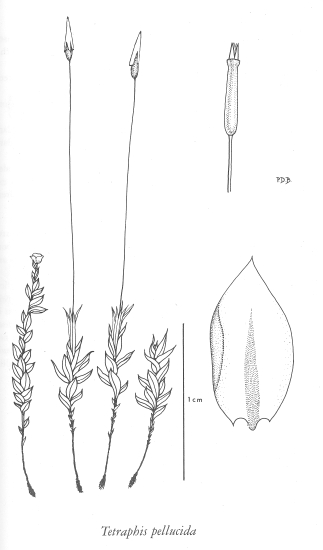Tetraphis pellucida Hedw.
common four-tooth moss (tetraphis moss)
Tetraphidaceae
Species Account Author: Wilf Schofield
Extracted from Some Common Mosses of BC
Introduction to the Bryophytes of BC
common four-tooth moss (tetraphis moss)
Tetraphidaceae
Species Account Author: Wilf Schofield
Extracted from Some Common Mosses of BC
Introduction to the Bryophytes of BC
Species Information
Species description:
Genus name refers to the four teeth of the peristome. Species name refers to the transparent leaves (when wet).
Comments:
With diligence, it is possible to find tiny, rounded, leaf like flaps growing on the shaded, rotten-wood habitat of Tetraphis; these structures precede the appearance of the leafy shoots. They are clearly visible with a 10X hand lens but can be
Distinguishing characteristics:
The gemma-cup bearing shoots, the four unjointed peristome teeth and the usual habitat on well decomposed, but friable wood are useful characters.
Habit:
Forming short, dense to loose, dark to pale green turfs of erect, unbranched plants.
Similar Species:
T. geniculata is very similar but the seta has a sharp, angular bend in the middle. Aulacomnium androgynum grows in similar, but usually drier, sites and produces gemma-bearing shoots which are terminated by a sphere of gemmae that are not enclosed in a "cup" of leaves; sporophytes of Aulacomnium are grooved and have many jointed peristome teeth.
Illustration

If more than one illustration is available for a species (e.g., separate illustrations were provided for two subspecies) then links to the separate images will be provided below. Note that individual subspecies or varietal illustrations are not always available.
Illustration Source: Some Common Mosses of BC
Habitat and Range
Habitat
Usually on decomposing stumps and logs of coniferous trees within coniferous forests also on peaty banks; from sea level to sub alpine elevations. Range
World DistributionCircumpolar in the Northern Hemisphere; in North America widespread across the continent, extending southward in the east to South Carolina and in the west to California, Arizona and Colorado.
Status Information
| Scientific Name | Origin Status | Provincial Status | BC List (Red Blue List) | COSEWIC |
|---|---|---|---|---|
| Tetraphis pellucida | Native | S4S5 | Yellow | Not Listed |
| Tetraphis pellucida var. pellucida | SNR | Not Reviewed | Not Listed | |
| Tetraphis pellucida var. trachypoda | SNR | Not Reviewed | Not Listed |
BC Ministry of Environment: BC Species and Ecosystems Explorer.